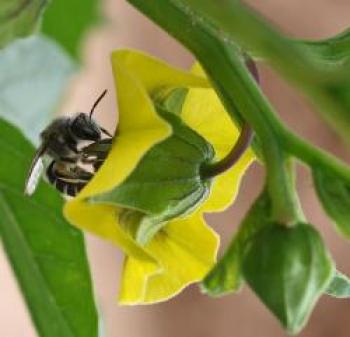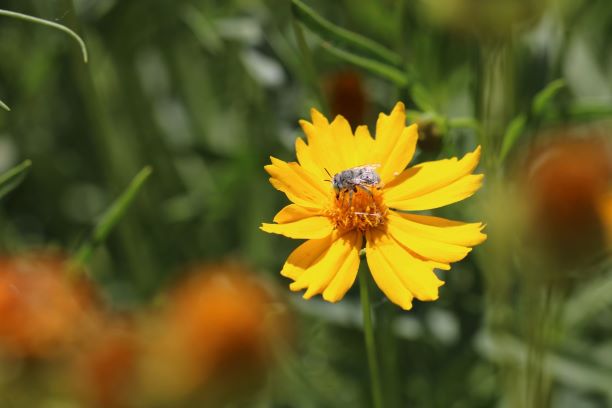IPM for Pollinator Health

Native bee pollinating tomatillo

Native bee pollinating Coreopsis lanceolata
Although an important pollinator, honey bees are not native to the United States and are not the only bees helping pollinate your farms and gardens; there are over 1,000 native bee species in New Mexico. These, along with other pollinators, all contribute to ecosystem services. Many stakeholders seek information on strategies to augment pollinators and increase pollination services to gardens, farms, and natural areas. To design pollinator habitat, our past and present research addresses the attractiveness of plants used in NM as well as the attractiveness of planting combinations for beneficial insects.
Resources
- Planting for Pollinators (PDF)
Planting for Pollinators - project at Las Vegas NWR
- Perennial Pollinator Plants (PDF)
These cards list which insect groups had the most visits to the plants in our research plots and considerations on including them in your own plantings.
Current Research
The Los Lunas Agricultural Science Center (ASC) is focused around investigating combinations of NM native plants that will specifically target specific beneficial insect groups for conservation and pollination services. A demonstration research plot was established in 2018 to address stakeholder questions regarding ideal planting combinations for pollinators and other beneficial insects.
The objective of this applied research is to develop and evaluate three flower mixes that are designed to attract different groups of beneficial insects.
The three mixes include:
- A bumble bee mix
- A solitary bee mix
- A natural enemy mix
Anticipated outcomes include increased awareness around the value of specific planting combinations in attracting and conserving pollinators and more habitat installed for pollinators.
Past Research
At the ASC, in collaboration with the NRCS Plant Materials Center for New Mexico, more than 100 species of (mostly native) plants were tested for their ability to attract and retain pollinators and other beneficial insects.
The project started in 2010 at the Los Lunas Agricultural Science Center/NM Plant Materials Center.
Thanks to funding from the Western IPM Center, this study was replicated at three other sites:
- The Farmington Agricultural Science Center
- The Tucumcari Agricultural Science Center
- And an additional site in Vado, NM
The information from these trials was used to draw up a comprehensive list of recommended plants that will help sustain pollinators in different parts of the state (see below).
- Pollinator Plants for New Mexico (PDF) - Publication by USDA and partners

Part of the pollinator planting at the Los Lunas Agricultural Science Center/NRCS Plant Materials Center for New Mexico